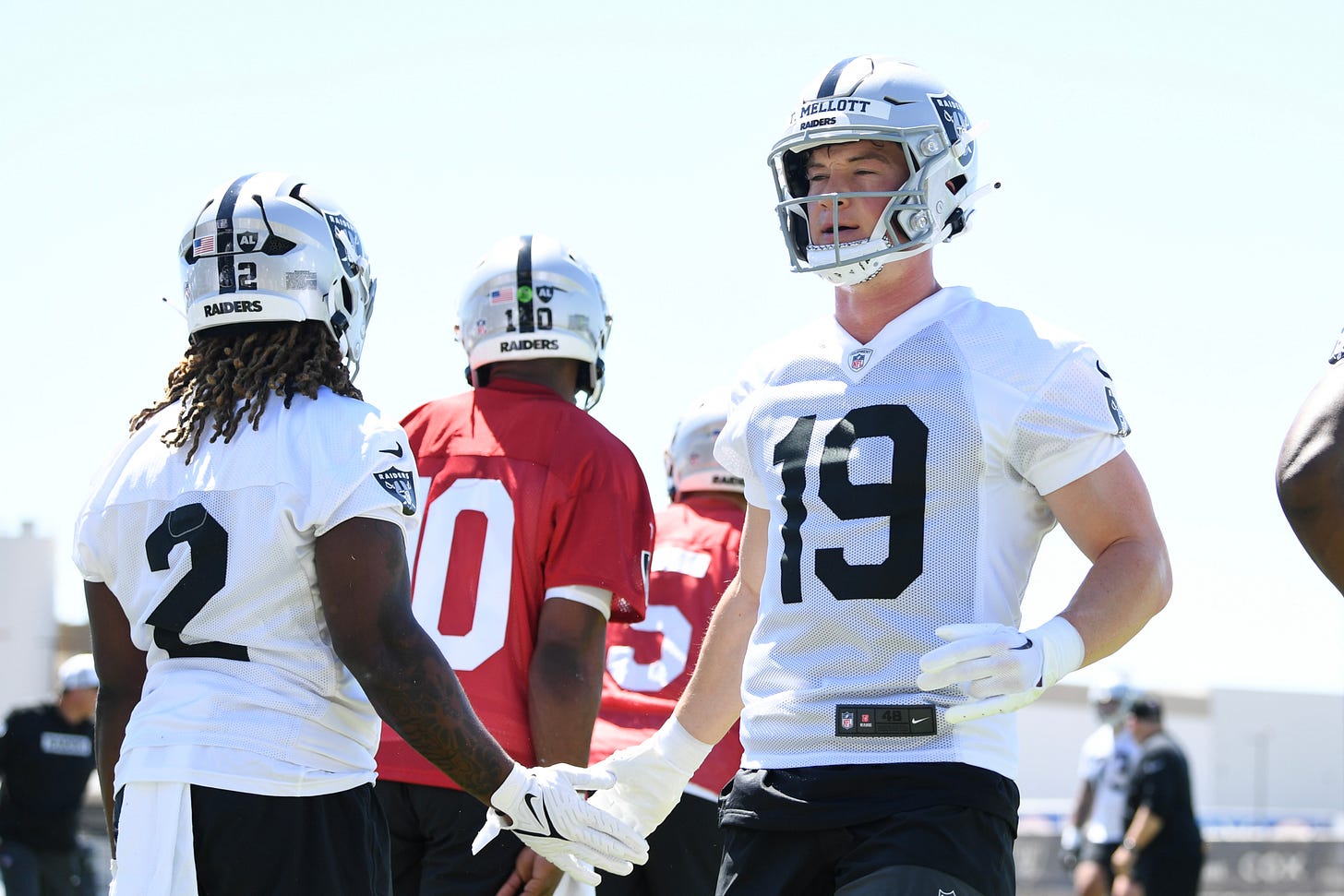The History of Converting QBs to Receiver And What It Means for Tommy Mellott
Ben Glassmire loves when players change positions, so he dove into some passers who successfully became pass catchers and why Tommy Mellott is the next man up.
I’m a sucker for a good position switch, which I know is a weird thing to get excited about. I was pumped when the Raiders converted Darren Waller to tight end from wide receiver. I thought Antonio Gibson going from wide receiver to running back would pay off big time for the Washington Commanders.
I don’t know what gets me so excited about it, but seeing these jaw-dropping athletes learn a new position so quickly is a baffling accomplishment. It’s even more impressive if they achieve even a small amount of success or make a roster in a league where teams only have 53 spots available.
Waller and Gibson’s position switches are significant changes in certain respects, but they pale in comparison to switching from a position where throwing the ball is your main task to catching the ball.
The ever-increasing reliance on mobile quarterbacks means the pipeline of passers converting to wide receiver is as strong as ever. While most players who make this switch don’t have a significant impact in the NFL, some notable exceptions foster hope for future quarterbacks who lack the traits to succeed as passers.
If a player is a high-level athlete, the NFL will always try to find a spot for them. Take a player like Joe Webb, who was drafted by the Vikings in 2010.
Webb remains one of the most athletic players to ever come out of college. He scored a 9.99 Relative Athletic Score (RAS) as a wideout despite switching positions pre-draft. After throwing for 5,771 yards and 37 passing touchdowns in his career, teams looked at Webb’s athleticism and back-to-back 1,000-yard rushing seasons and identified him as a position change candidate.
Oddly enough, Webb would have one of the stranger careers in NFL history. Despite working out at wide receiver and expecting to make the full-time switch in the NFL, the Vikings drafted him in the sixth round and started him out at quarterback.
He started two games at quarterback as a rookie, showcasing his athletic upside by recording 120 rushing yards. But he struggled as a passer, recording three interceptions without a touchdown. The Vikings used Webb’s unique skill set in a specially designed “Blazer” package to capitalize on his athleticism.
Webb improved moderately as a passer during his second year, but his future in the league was not as a quarterback. After his Vikings tenure concluded in 2013, Webb signed with the Carolina Panthers, who, despite listing him at quarterback, never used him there. Instead, he was primarily a kick returner and occasionally played wide receiver.
The former passer stuck around until 2021 when the New York Giants released him for the final time. Despite never making a significant on-field impact, Webb carved out an impressive career for a player with no defined position. Conservative coaches or uncreative playcallers will often shy away from players like Webb due to the time commitment and patience required for them to find success at the NFL level.
Webb isn’t even the best example of quarterbacks who have switched positions. Still, he’s an excellent case study in how teams can move players around if they have translatable physical traits and the work ethic to commit to the new position.
The QB-to-WR pipeline Has Recent Success Stories
I am contractually obligated to start this section with former Patriots receiver Julian Edelman, who caught one pass in college and wasn’t particularly remarkable at quarterback.
The undersized passer had a 30:31 touchdown-to-interception ratio at Kent State but did make an impact on the ground, rushing for more than 1,300 yards as a senior. His athleticism and skill with the ball in his hands were a big reason the Patriots gambled on him in the seventh round.
Webb and Edelman were prolific runners in college, a prerequisite for teams to consider moving a quarterback to wide receiver.
But Edelman also had a willingness to make the switch. To be successful when making such a drastic career move, the player must fully commit to understanding all the fundamentals needed at wide receiver. Any quarterback making the switch will compete against players who have played receiver for years, and beating out an NFL depth receiver is not easy.
Edelman is a rare case. He was routinely praised for his work ethic and drive to succeed, and the Patriots recognized this during his time at Kent State. Although they knew he wouldn’t succeed at quarterback, by combining his athleticism and work ethic, they got a massive return on their investment of a seventh-round pick.
That work ethic made him an excellent fit for the “Patriot Way” and would ultimately turn him into one of Tom Brady’s top targets. Some players won’t be willing to make the switch and sacrifice what they have worked for as quarterbacks.
Keep reading with a 7-day free trial
Subscribe to Wide Left to keep reading this post and get 7 days of free access to the full post archives.




